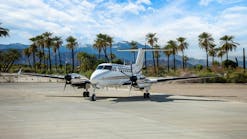[w/locator map]
Environmentalists fear that a new Las Vegas regional airport, within 15 miles of the Mojave National Preserve, would disrupt the tranquility of the remote desert parkland whose major attraction is its serenity.
An environmental impact statement is being prepared for the Ivanpah Valley airport, proposed at a 5,800-acre site between Primm, Nev., at the Nevada-California state line, and Jean, Nev.
It would supplement passenger service at the existing McCarran International Airport at Las Vegas, which will reach capacity in 2017, said McCarran spokeswoman Elaine Sanchez.
"Potential noise from aircraft takeoffs and landings, as well as increased traffic on Interstate 15 past the preserve will be extremely detrimental to the solitude enjoyed at the national park,' said environmentalist Peter Burk of Barstow.
"The draft impact statement needs to consider alternate locations for the airport that would be less damaging to the environment.'Howard Gross, California desert program manager for the National Parks Conservation Association, notes that legislation transferring federal land to Clark County, Nev., for the airport calls for an airspace management plan.
"But jumbo jets turning at the boundary of Mojave National Preserve during takeoffs and landings will certainly impact the park's natural soundscape,' he said.
The Federal Aviation Administration and the U.S. Bureau of Land Management have awarded a $14.2 million contract to Massachusetts-based Vanasse Hangen Brustlin Inc. , a transportation and environmental firm, to prepare the document.
The environmental study is expected to be completed by 2010, said Bill Wrinn, public relations spokesman for the firm.
"All potential impacts will be studied closely,' he said.
Initial flight operations are expected to begin at the $4billion Ivanpah airport by 2017, when McCarran International Airport at Las Vegas reaches its passenger capacity.
According to Sanchez, the Ivanpah Valley airport would serve international and domestic long-haul passenger flights, charter aircraft, and international and domestic cargo.
"It will be designed to ultimately handle up to 35 million passengers,' she said.
Las Vegas, among the nation's fastest growing cities the past decade, now attracts 10million more visitors than it did in 1995, Wrinn said. About 5,000 people become permanent residents every month. The growth compounds the demand for a new airport.
Clark County paid $20.7million for the Ivanpah Valley site, about 30 miles southwest of Las Vegas.
"After careful evaluation, it was determined that the Ivanpah Valley was the last site in southern Nevada that meets criteria for the airport,' Sanchez explained.
There are no high mountains nearby, and there is a minimum of commercial and residential development in the immediate area. Further, airspace does not conflict with aircraft using McCarran or Nellis Air Force Base, near Las Vegas.
"Although Ivanpah Valley airport would handle less traffic than McCarran, we're planning on a larger site to provide a buffer for noise and incompatible development abutting the airport,' she said.
Environmental scoping sessions for the proposed airport will be held in 2006, said Randall Walker, director of the Clark County Department of Aviation.
A survey of visitors to the 1.6million-acre Mojave National Preserve indicated that travelers turn off Interstate 15 and Interstate 40 to enjoy the park's unspoiled vistas and uncrowded back roads as well as its forests of Joshua Trees, its lofty sand dunes and endangered wildlife.
"We're concerned with the proposed airport because of its relative proximity,' said park spokesman James Woolsey.
"When [recent] legislation was passed that created an opportunity for Las Vegas to transfer land from government ownership, we have been involved in the process of mitigating potential impacts,' he said.
Gross, who is based at the conservation association's Joshua Tree office, is afraid the airport would diminish the clarity of the night sky over the preserve.
"You can already see a substantial glow on the horizon at night,' he said.
"With a major airport so close to the park, we are very concerned that two of the preserve's most treasured values its piercing quiet and its dark night skies could be lost.'
Copyright 2005 LexisNexis, a division of Reed Elsevier Inc. All rights reserved.
Terms and Conditions | Privacy Policy
News stories provided by third parties are not edited by "Site Publication" staff. For suggestions and comments, please click the Contact link at the bottom of this page.





